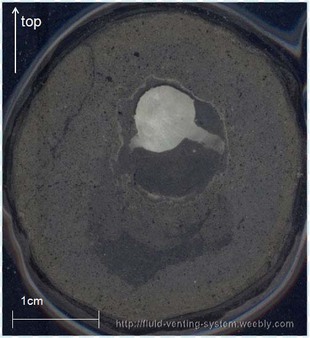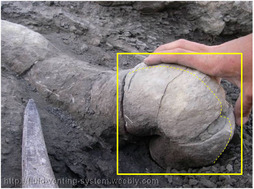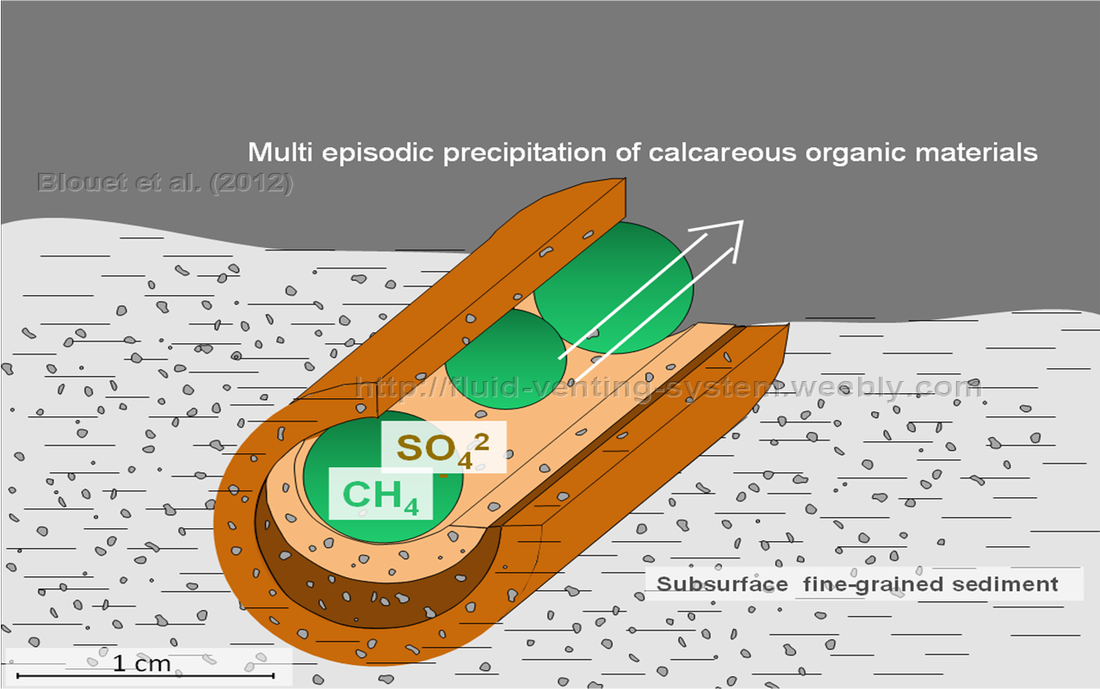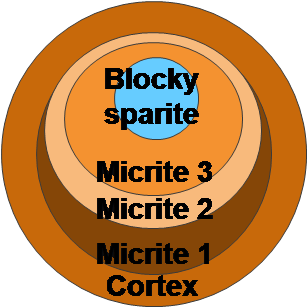Petrography and internal structures of MDAC tubes
(Extracted from Blouet, PhD thesis)
Annular structures of infill sediments that represent different generations of depositional event can generally be observed on latitudinal and longitudinal sections of MDAC tubes (cf. Krause et al., 2009; Haas et al., 2009; Agirrezabala, 2009). Optic and electron microscopic observations indicate that the internal infills of MDAC tubes are most of time composed by micrite, as well sparry, blocky and/or fibrous calcite, aragonite (cf. Campbell et al., 2002; Agirrezabala, 2009). In some cases solid bitumen is presented in the cement (click here) (Agirrezabala et al., 2008).
The example below is a MDAC tube in our study which exhibits a complex sequence of sedimentary infills and indicates a series of diagenetic events (fig. 1).
Fig. 1. A thin section of a latitudinal section of MDAC tube. Right) See in nature light. Left) Annotations indicate different kinds of infills.
|
Sedimentary infills can be very localized at specific parts inside MDAC tubes. A longitudinal section of the tube demonstrate that a same paragenetic sequence is not necessary present all along the tube and can be absents at certain locations.
A longitudinal section of a studied MDAC tube's segment (Fig. 2) shows asymmetric depositional layers inside the central conduit (Fig. 3). Calcite-filled cracks are observed cutting cross the central conduit or extended along the latter's side wall (Fig. 3). |
Results from several geochemical analysis (not shown in here) demonstrated that infill events of the MDAC tube were complex, and the superimposed order of infill layers were not necessary indicated the chronological order of the infill depositions (Fig. 4).
A reconstruction of order of infill deposition is based on the geochemical results (not shown in here) as well referred to the infill geometries (Fig. 5).
On the latitudinal section of the MDAC tube in Fig. 1, a more detailed structure of the internal infill is revealed under microscopy. Fine lamination of sand layers are paralleling to the micritic layers (fig. 6).
Fig. 6. A thin section of a latitudinal section of MDAC tube under microscopy. Left) The thin section shown in fig. 1 in earlier. Middle) A zoom in view of the white square area in picture in the left. Laying structure is visible. Right) Laminating sand layers are highlighted by black dot line
Hypothesis on the formation of MDAC tube and the infill process
(Presented in 11th Conference of Gas in Marine Sediment by Blouet, J. P., Imbert, P. & Ho, S., 2012)
|
Key words: Jean-Philippe Blouet fault Sutieng Ho methane authigenic carbonate
|
|
|

Fluid-Venting-System website by S. HO is licensed under a Creative Commons Attribution-NonCommercial-NoDerivatives 4.0 International License.



























